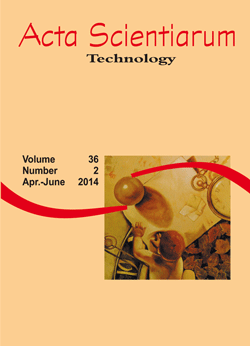<b>Convective drying of regular mint leaves: analysis based on fitting empirical correlations, response surface methodology and neural networks<b>
DOI:
https://doi.org/10.4025/actascitechnol.v36i2.19238Palavras-chave:
Mentha x villosa H, kinetic parameters, convective drying, moisture contentResumo
In the present work, an analysis of drying of peppermint (Menta x villosa H.) leaves has been made using empirical correlations, response surface models and a neural network model. The main goal was to apply different modeling approaches to predict moisture content and drying rates in the drying of leaves, and obtaining an overview on the subject. Experiments were carried out in a convective horizontal flow dryer in which samples were placed parallel to the air stream under operating conditions of air temperatures from 36 to 64°C, air velocities from 1.0 to 2.0 m s-1 and sample loads from 18 to 42 g, corresponding to sample heights of 1.4, 1.7 and 3.5 cm respectively. A complete 33 experimental design was used. Results have shown that the three methodologies employed in this work were complementary in the sense that they simultaneously provided a better understanding of leaves drying.
Â
Downloads
Downloads
Publicado
Como Citar
Edição
Seção
Licença
DECLARAÇíO DE ORIGINALIDADE E DIREITOS AUTORAIS
Declaro que o presente artigo é original, não tendo sido submetido í publicação em qualquer outro periódico nacional ou internacional, quer seja em parte ou em sua totalidade.
Os direitos autorais pertencem exclusivamente aos autores. Os direitos de licenciamento utilizados pelo periódico é a licença Creative Commons Attribution 4.0 (CC BY 4.0): são permitidos o compartilhamento (cópia e distribuição do material em qualqer meio ou formato) e adaptação (remix, transformação e criação de material a partir do conteúdo assim licenciado para quaisquer fins, inclusive comerciais.
Recomenda-se a leitura desse link para maiores informações sobre o tema: fornecimento de créditos e referências de forma correta, entre outros detalhes cruciais para uso adequado do material licenciado.















